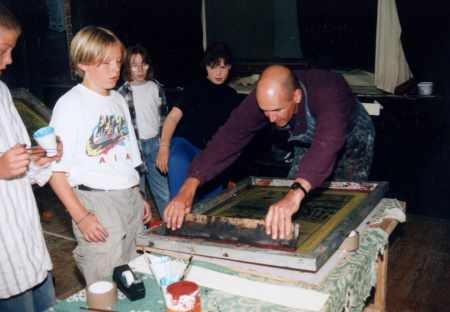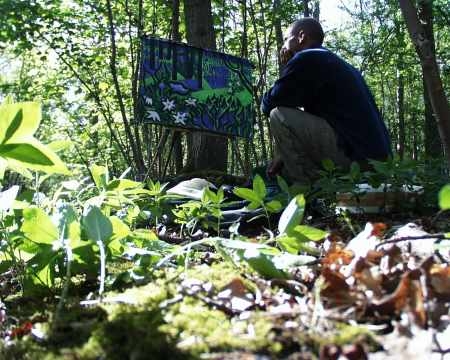Interview with Burcu Arik of Doga Dernegi in Turkey
(I’ve included it here because I think the answers to the questions mostly hold true for me and they’re here on tap if somebody asks again).
When did you start painting and how?
Although I used to paint a bit when I was a child, and started to draw to describe birds (especially rare birds) it wasn’t until I visited the arctic tundra as part of a season censusing birds in Canada that I resolved to learn to express myself through drawing/painting.I was with one other ornithologist, in a tent on a beach ridge hundreds of miles from the nearest people. Icebergs offshore, caribou migrating, arctic fox on the neighbouring ridge and all kinds of exotic birds in this clear, near 24 hour light. It was a sensory overload and I didn’t know what to do with it. Some of the time I had to retreat into the tent. I made a resolution to study art as soon as I returned to Britain.
You mainly paint about nature. How you feel when you are in nature?
When out in wilder places I suppose I mainly feel at home. Enjoying something huge that is always changing. On the one hand recognising familiar things that might be expected and then being surprised by something unpredictable. I love trying to understand the patterns in nature that exist in time… the change over a day or a year; and in space the way different creatures or plants occupy different places.
How do you feel when painting? What do you like to paint?
Nowadays when painting or drawing I will have looked at my subject for a long time and in some way tried to memorise it. This isn’t a memorising of it’s external features… so not tracing around it in my mind… but memory of feelings… some of it trying to get inside the thing… what would it be like to be that creature?… or what does looking at particular shapes/patterns/colours/movements makes me feel like?
The paper on which I’ll paint then becomes a container to put my thoughts into… by putting them onto the paper they change…. they aren’t a flower or a bird… they are just painting marks on paper… something new.
By making that new thing it is as if it has it’s own taste or smell… the painting or drawing has a character of it’s own that started out from watching a specific thing.
What can you suggest for children who would like to start painting? How to start? How to proceed? Is it an easy job painting or…?
I don’t think there are any special tricks to painting it’s just doing it. It’s like writing this now… there isn’t a right answer to your question. I just write something and it will be more or less like I feel. Another day I would give a different answer to the same question.
If I want to draw or paint then I just have to do it…. and then what happens will take care of itself… I think it’s not a good idea to judge a drawing whilst doing it…. don’t say “this is a bad or good drawing”… just make lots of drawings/paintings. Try different ways of making them…. quick ones/slow ones, big ones/small ones…. use colour or just use line.
Afterwards when you have made a lot you may be able to say ‘yes, number 48 is more successful than number 2’.
Drawing outside I would recommend just looking as hard as you can…. try to find what most excites you about the bird, plant or landscape and then try different ways of expressing that.
Indoors using collage can be very liberating…. take some coloured paper (maybe not too many colours) and then rip or cut with scissors some pieces of paper that suggest the thing you are trying to ‘paint’. Try to imagine how these will look before you stick them onto your piece of paper…. a big grey block will make something big and slow (an elephant)…. little blue dots will make something quick and sporadic (a flying jay)… It is often surprising how much of the character of an animal you can capture with very crude shapes….
Maybe try drawing /painting over the collage. Try one with just collage, then one with a painted line to go over the paper shapes
Do you work with children? Can you give examples?
I have given printmaking classes to children on a few occasions. Twice this has been making hand printed books using silkscreens.
The photo here is from an arts festival week in the west of Ireland. (note to self -show the book).
Another time I made something similar where the children had been looking at nature in their local cemetery in London and made small books about that.
What were you doing before painting? Can you explain briefly? Do you miss your previous job?
Before painting I did some conservation work, worked at bird observatories and taught English in Spain. For nearly 20 years now I have been a self employed artist. It is important to me to just try and go deeper into this one thing… I now have a language to describe what I see … it isn’t easy but this is the thing I most wanted to do….so I don’t miss things from the past.
What countries you visited for painting?
Maybe the easiest countries to talk about visiting are those I have gone to with Artists for Nature foundation….this organisation gets a group of International artists to visit an area to raise awareness of the wildlife there and hopefully help people appreciate the qualities of the place.
I have taken part in 4 of these projects… the Loire estuary in France, Bhandavgarh in central India, the Spanish Pyrenean mountains and the southern coast of Portugal.
Each time it has been like taking a group of trained eyes to the region, with all their artistic and natural history experience.
The finished product has been a series of exhibitions and a book.
What is your favourite/exciting moment of painting?
My favourite moments of painting are when I know a subject really well…. common birds say and I’ve spent a long time watching and got to know the area that they are moving around. Then settling down on the ground, no longer looking at the birds but still hearing them and smelling the vegetation, feeling the wind or sun and starting to paint. At that point time disappears and it’s a bit like being in a trance. It feels like for a little time that I have started to sink into the ground and absorb something of the place.
Main techniques you are using?
The main techniques I use are based around printmaking… and the qualities I value from the processes are simplifying things… so if i make a woodcut I ‘draw’ directly with sharp gouges which means that I have to make bold marks that can’t be changed.
Printmaking often means working in layers, you print one layer and then make a second or third that lays over or under the first. This way of working tends to give surprises… the way one colour looks when it is over the top of another for example.






